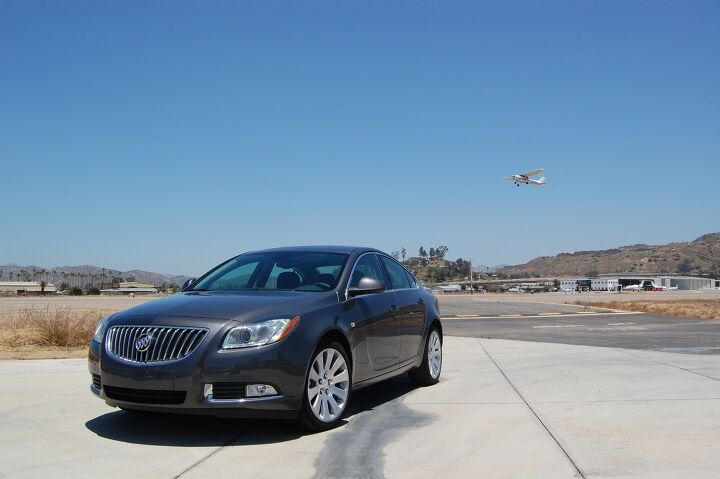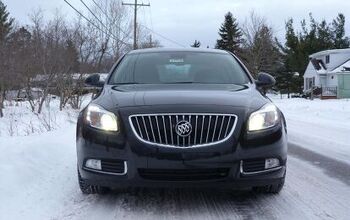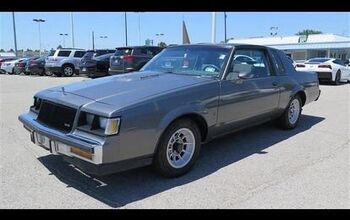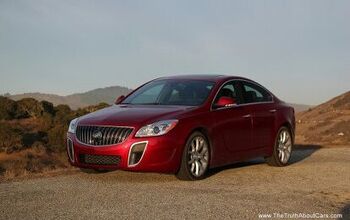Review: 2011 Buick Regal Turbo
Taut. Trim. Modern. Sporty. Developed in Germany. Aimed at youthful enthusiasts. Stop me when it starts sounding like I’m describing a Buick.
Since the launch of the Enclave in 2007, Buick has repeatedly touted a decline in average buyer age that still has yet to push the brand’s demographics into the fat sections of America’s population pyramid. Though the year-old LaCrosse appears to be helping Buick’s central PR narrative, even it is, at best, not your grandfather’s Buick. Despite a brand heritage based on a traditional, suburban American image whose fading appeal is evidenced in Buick’s pre-Enclave demographics, the long-term health of GM’s entry-luxury (or “premium,” to use GM-speak) marque depends on continued progress away from the “blue hair” image it has so richly earned over the past several decades.
It should come as no surprise then, that the 2011 Regal is the most substantive break from Buick’s past to date. And no wonder: born in Germany as the Opel/Vauxhall Insignia, the Regal is as traditionally American as a Kraftwerk album. In Europe, the Insignia is sold as fashion-forward competitor in the mass-market, midsized segment. In the context of a Buick that still offers a taste of the geriatric image it’s desperate to escape in the G-Body Lucerne, the Regal is unapologetically marketed as a sports sedan. And until a recently-approved high-performance GS version arrives, the 220 horsepower Turbo version is the bellwether for both the Regal’s sporting pretensions and Buick’s desire to attract a new kind of buyer.The decision to launch the Regal on 200 miles of twisting road east of San Diego, California is testament to just how much Buick believes in the Regal’s sporting credentials. And this was no mirror-smooth, touring course either. Tight hairpins, deep compressions, nasty potholes and impossibly narrow, rough roads left the Regal no opportunity to fake the funk. Nausea-control armbands left in each Regal’s center console weren’t just for show either: several of Buick’s reps were looking decidedly green around the gills at the stopsbetween driving stages.
And no wonder. The Regal Turbo we tested proved not only to be the best-handling Buick ever (damning with faint praise, to be sure), but also an accomplished athlete by any reasonable comparison. The Regal Turbo is by far the most enthusiast-oriented application of GM’s Epsilon II platform to date, and was, throughout the test, a poised and willing dance partner. The front-drive chassis provided considerable grip through fast sweepers, performed sharp direction changes with aplomb and carried its 3,600 pound claimed curb weight with unexpected grace. And though a far cry from the squishy, all-day touring comfort that previously defined Buick chassis and suspension setups, it never felt overly harsh or hard-core. Even fitted with optional 19 inch wheels (reminiscent of the Jaguar XF’s), the ride remained impressively smooth.Of course, on the kind of roads that one finds in the hill country east of San Diego, a well-settled chassis alone isn’t enough to deliver true enthusiast performance. The loaded Turbo model we drove was equipped with an active damping system that will be optional on Turbo models when they arrive at dealer lots later this year. With this option comes the choice of three modes, Normal, Touring and Sport, selectable with buttons on the instrument panel. According to the engineers responsible for developing the Regal Turbo, the car itself will even choose between the different modes based on its analysis of real-time telemetric data.difference in suspension, steering and drivetrain settings were immediately noticeable, and is clearly responsible for many of the superlatives in this review. Because Sport mode is self-activating, however, it’s hard to say how a Turbo model without active damping would perform, and its advantages are based on an imperfect comparison to the 2.4 liter, normally-aspirated base Regal with 18 inch rims.
But even with the performance-enhancing wheel and active suspension upgrades, the Regal Turbo we drove was not a perfect athlete. The impressively-fettled chassis, and firm, flattering suspension were consistently let down by a hydraulic-assist steering setup that failed to live up to the Regal’s promise of sports sedan performance. From the moment I slid behind the wheel, it felt almost comically disconnected from the wheels, and driving through downtown San Diego in Touring mode, my concern with the super-light, feedback-free, and vague on-center feel through the Regal’s helm only grew. Based on the number of fellow testers who waggled their wheels in curiosity on the way out of town, like Formula 1 drivers breaking in their tires on a warm-up lap, I wasn’t the only one who took notice.And sure enough, as soon as the drive’s first leg got into the curvy stuff, the steering came into focus as the weakest link in the enthusiastic driving equation. The vagueness on-center, which was mitigated (but not removed) by pressing the Sport button, robbed the Regal’s driver of confidence when diving into an apex, while the overboosted lightness prevented a steady flow of communication between the road and the driver. As a result, it was extremely difficult to feel out the limits of the Regal’s capability, and one couldn’t help but get the impression that an otherwise capable chassis was going underexploited. Moreover, it limited the Regal’s ability to flatter the driver, an key consideration for an entry sports sedan.entirely-musical note as the engine charges up the rev counter. The results are certainly effective, feeling at least the claimed second faster to 60 MPH than its normally-aspirated cousin, and in non-enthusiast driving it’s smooth, refined and quiet.
As an enthusiast-oriented engine, however, it could stand to offer more in the way of soul. In fact, the lack of rev-rewards almost make the wait for manual transmission versions (coming in Q4 of this year) a non-event. Almost. Unfortunately, the six-speed automatic also takes away slightly from the Regal’s dancing abilities. Letting off the throttle and brushing the brakes on the entrance to a corner almost always leaves the slushbox in a higher gear than the exit requires. Truly spirited driving requires almost constant contact with the gas pedal, and early, subtle throttle inputs to keep the transmission from confusing itself coming out of a tight bend (the transmission offers a “manual” mode which helps in this regard, but not paddle shifters which are even available on the Malibu). Luckily, the chassis can take corners at a high enough speed to allow earlier gassing than you might expect, but tight hairpins can take some wind out of the Turbo’s progress and stringing fast corners together takes some planning. Again, it wouldn’t be at all fair to call the Regal “unsporty” on this count, but it also doesn’t flatter the driver the way a true enthusiast’s sedan can.But there I go again, criticizing a Buick for failing to live up to “true enthusiast” standards. In the real world the Regal Turbo is not only more than capable of entertaining anyone currently considering a front-drive, four-door sedan, it also offers an experience that jives surprisingly well with my concept of what a Buick should be. The smooth, quiet powerplant is complimented by a an impressively quiet cabin, which in turn compliments the chassis’s well-moderated balance between ride and handling. The exterior styling, though an undeniable break from Buick’s heritage of ventiports and sweep-spear lines, is handsome and well-detailed but subtle nearly (although not quite) to the point of anonymity. How Buick is that?More by Edward Niedermeyer
Latest Car Reviews
Read moreLatest Product Reviews
Read moreRecent Comments
- Probert They already have hybrids, but these won't ever be them as they are built on the modular E-GMP skateboard.
- Justin You guys still looking for that sportbak? I just saw one on the Facebook marketplace in Arizona
- 28-Cars-Later I cannot remember what happens now, but there are whiteblocks in this period which develop a "tick" like sound which indicates they are toast (maybe head gasket?). Ten or so years ago I looked at an '03 or '04 S60 (I forget why) and I brought my Volvo indy along to tell me if it was worth my time - it ticked and that's when I learned this. This XC90 is probably worth about $300 as it sits, not kidding, and it will cost you conservatively $2500 for an engine swap (all the ones I see on car-part.com have north of 130K miles starting at $1,100 and that's not including freight to a shop, shop labor, other internals to do such as timing belt while engine out etc).
- 28-Cars-Later Ford reported it lost $132,000 for each of its 10,000 electric vehicles sold in the first quarter of 2024, according to CNN. The sales were down 20 percent from the first quarter of 2023 and would “drag down earnings for the company overall.”The losses include “hundreds of millions being spent on research and development of the next generation of EVs for Ford. Those investments are years away from paying off.” [if they ever are recouped] Ford is the only major carmaker breaking out EV numbers by themselves. But other marques likely suffer similar losses. https://www.zerohedge.com/political/fords-120000-loss-vehicle-shows-california-ev-goals-are-impossible Given these facts, how did Tesla ever produce anything in volume let alone profit?
- AZFelix Let's forego all of this dilly-dallying with autonomous cars and cut right to the chase and the only real solution.









































Comments
Join the conversation
Just listened to a Radio Interview with Tony LaRoque from GM Canada about the Buick Regal, saying that GM is going after the Acura product with this new Buick! He also said that this Car would be soon be built in Oshawa, Ontario, I guess we all will have to wait to see what develops on this idea.
The question I keep asking myself is how much does it cost to repair since its made in Germany? I heard that is a major issue with the Holden built GMs. Almost Jake